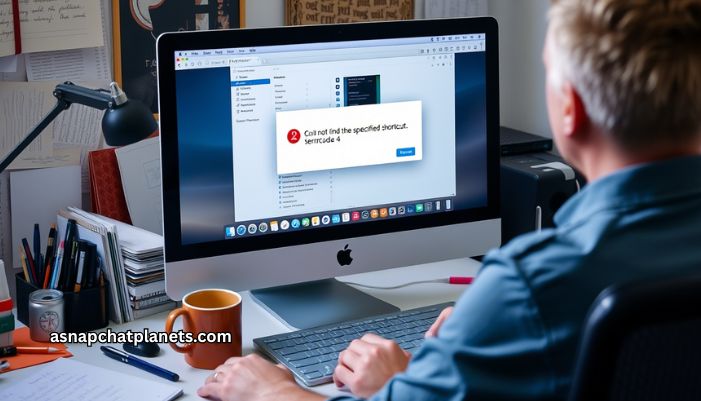You might be working on your Mac—opening a file or launching an app—and then you see a strange message like this:
“errordomain=nscocoaerrordomain&errormessage=could not find the specified shortcut.&errorcode=4”
At first, this may look scary. But don’t worry. Your Mac is not broken. It just can’t find a file or shortcut it needs.
In this post, we’ll explain what this error means, why it happens, and how to fix it step by step. We’ll keep things simple and clear, even if you’re not great with tech stuff.
What Does the Error Mean?
Let’s break down the message:
- NSCocoaErrorDomain: This tells us the error is from Apple’s system. It works behind the scenes when apps run.
- Could not find the specified shortcut: The Mac is looking for something, but it’s not there.
- Error code 4: This means the file or shortcut is missing.
So, your Mac is saying,
“I’m trying to open something, but I can’t find it.”
It could be a file, a link, or a shortcut that was moved or deleted.
Why You’re Seeing This Error
There are a few common reasons why this shows up:
1. The Shortcut Is Missing
You (or an app) may have deleted or moved the shortcut. So when the Mac looks for it, it can’t find it.
2. A Bug in the App or macOS
Sometimes, the app or your Mac system has a small bug. It thinks a file is there, but it’s not.
3. iCloud or Sync Problems
If you use iCloud Drive or services like Dropbox, your files may not live on your Mac anymore. They might be in the cloud.
4. Permissions Are Wrong
Your Mac may block access if the app or system doesn’t have permission to open the file.
How to Fix “Could Not Find the Specified Shortcut”
Follow these simple steps. Start with the easiest one first.
Step 1: Restart Your Mac
Yes, the classic restart. It works more often than you think.
- Click the Apple logo.
- Choose Restart.
- Wait for your Mac to start again.
After restarting, try the same action again. Many errors vanish after a clean reboot.
Step 2: Look for the Shortcut
Check if the file or shortcut is really there:
- Open Finder.
- Use the search bar to type the shortcut’s name.
- See if it shows up.
If you don’t find it, it may have been deleted.
What to do: If you remember what the shortcut linked to, make a new one. Right-click the original file and click Make Alias.
Step 3: Clear Cache Files
Cache files are like digital dust. Too much of it can slow things down or cause errors.
Here’s how to clean it:
- Open Finder.
- Click Go in the top menu.
- Choose Go to Folder.
- Type
~/Library/Cachesand press Enter. - You’ll see many folders. Delete only the ones for apps you know (like Chrome or Spotify).
Then restart your Mac again.
Step 4: Check Your iCloud Settings
Your Mac might be trying to open a file stored in the cloud, not on your Mac.
To fix this:
- Open System Settings.
- Click on Apple ID.
- Go to iCloud > iCloud Drive.
- Click Options.
- Make sure Desktop & Documents is selected only if you want to sync those folders.
If the file is online-only, download it so your Mac can use it.
Step 5: Reset the App Settings
If the problem happens in a certain app, that app’s settings might be broken.
Here’s how to reset them:
- Quit the app.
- In Finder, press Command + Shift + G.
- Type
~/Library/Preferences/ - Look for files that include the app’s name.
- Move those files to the trash.
Now open the app again. It should start fresh.
Step 6: Recreate the Shortcut Manually
If the missing shortcut was one you made, you can create it again:
- Find the original file.
- Right-click and choose Make Alias.
- Move the alias to the folder you want.
Done! Now your Mac knows where to look.
Step 7: Use Console to Find the Source
Still stuck? Try using the Console app.
- Go to Applications > Utilities > Console.
- Open it.
- Do the action that causes the error.
- Look in Console for any error logs.
Look for messages with NSCocoaErrorDomain. This will tell you which app or system process is having the issue.
How to Avoid This Error Later
Good habits can help you avoid this problem in the future.
1. Don’t Delete Shortcuts Too Quickly
Before deleting any shortcut or alias, double-check what it connects to.
2. Know Where Your Files Are
If you use cloud services like iCloud or Dropbox, make sure you understand what’s stored locally vs. online.
3. Keep Your System Updated
Apple often fixes small bugs in system updates. Go to System Settings > General > Software Update to check.
4. Back Up Your Mac
Use Time Machine or another tool to keep backups. That way, even if something goes missing, you can restore it.
Conclusion
That long error message might look scary:
“errordomain=nscocoaerrordomain&errormessage=could not find the specified shortcut.&errorcode=4”
But in most cases, it just means something is missing. It might be a file, a link, or an app that lost track of what it needs.
The good news? It’s easy to fix. Restart your Mac, check for missing shortcuts, and clean up your settings. With just a little time, your Mac will be back to normal.
